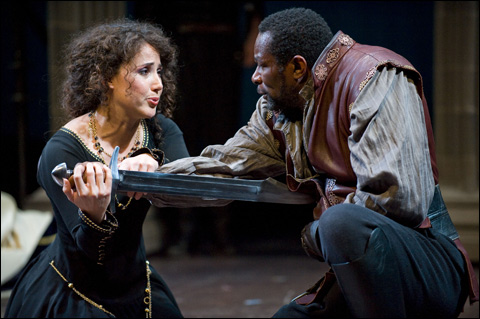
FLY WITH ME John Douglas Thompson’s Richard gives the hard sell to Leia Espericueta’s Lady Anne. |
Dreams and portents loom large in Richard III (at Shakespeare & Company through September 5). So it seems fitting that John Douglas Thompson's dynamic Dick Crookback should deliver the play's famed opening lines from a supine position on the floor, as if envisaging in slumber "the winter of our discontent/Made glorious summer by this sun of York." Once he's up, brimming with contempt for an effeminate peace and delighting in the prospect of his own villainy, you realize that Thompson will wear Richard's physical deformities as audaciously as he does his deviltry. His left shoulder supports a large hump and sprouts a useless arm — now in a sling, now held close to the actor's chest by his other arm. And his wide-legged, loping limp makes the Bard's "bottled spider," albeit confined to two legs, rock as much as strut as he ebulliently weaves the toxic web on whose strands he will ascend to England's throne.
Dubbed by no less than the New York Times "one of the most compelling classical stage actors of his generation," Thompson is best known for his recidivist Othello (at Trinity Repertory Company, American Repertory Theater, S&C, and New York's Theatre for a New Audience). Here he proves he'd also make a mean Iago, presenting not just a jocular, witty Richard but one who's quick to crow at his cruel successes and so impatiently, aggressively persuasive that the women (Leia Espericueta's sweet, sad Lady Anne and Tod Randolph's at first incredulous Queen Elizabeth) he moves from abrasive loathing to bewildered acquiescence do not seem schizoid or weak-willed. His power of seduction is that strong.
Its fast-moving scenes bridged by Bach and bustle, the S&C production, though exciting, can be disconcerting — as when Rocco Sisto's exquisitely quiet and evocative rendering of imprisoned Clarence's guilty dream of Hell and drowning is followed by the incursion of a couple of murderers straight out of The Sopranos. The mood swings between chilling urgency and circus barkering — the first epitomized by Elizabeth Ingram's magisterial bag lady of a Queen Margaret flinging her guttural curses, the second by the way Nigel Gore's ironical Buckingham and Johnny Lee Davenport's huckstering Lord Mayor of London rally the audience, as if they were fans at a football game, to persuade Richard to the crown. The jarring may in part be attributable to multiple cooks having stirred the directorial pot: new artistic director Tony Simotes (who directed Thompson in the powerful S&C Othello) conceived the staging but was sidelined by a health crisis, with Jonathan Croy (assisted by Malcolm Ingram) taking over. Then again, it may be just bold S&C business as usual, extremity and clarity being the twinned bulwarks of the company founded by the seldom-equivocal Tina Packer.
Richard III is hardly the most accurate of Shakespeare's histories, but S&C sets it squarely in the 15th century, scene of the two-year reign of the man who killed Henry VI (if not everyone else in his way), then lost both horse and crown at Bosworth Field. Patrick Brennan provides the movable, broken Gothic arches that form the set, Arthur Oliver the rich period costumes. Among the performances, Ingram's and Randolph's are almost as indelible as Thompson's. And there are authoritative turns — one rough, one smooth — by Gore and Jason Asprey as erstwhile Richard allies moving toward the ax, each reiterating the fierce curses of old Queen Margaret that have stuck not only to but also with them.